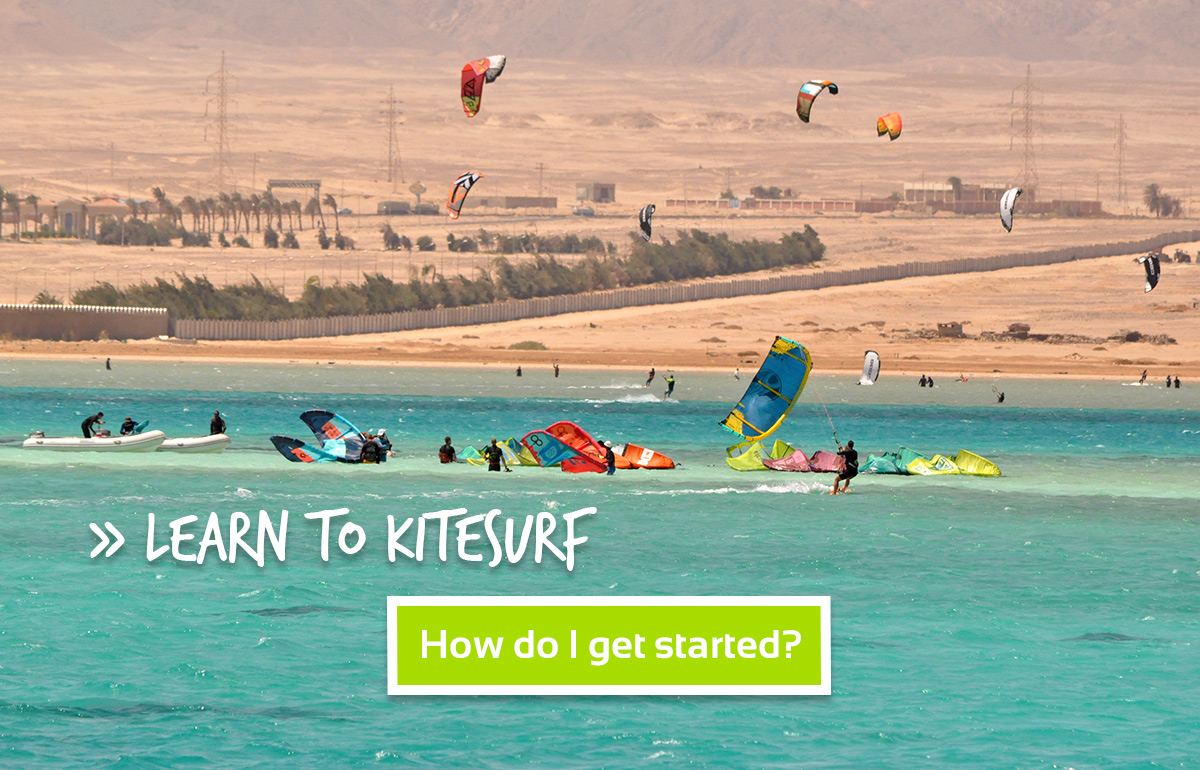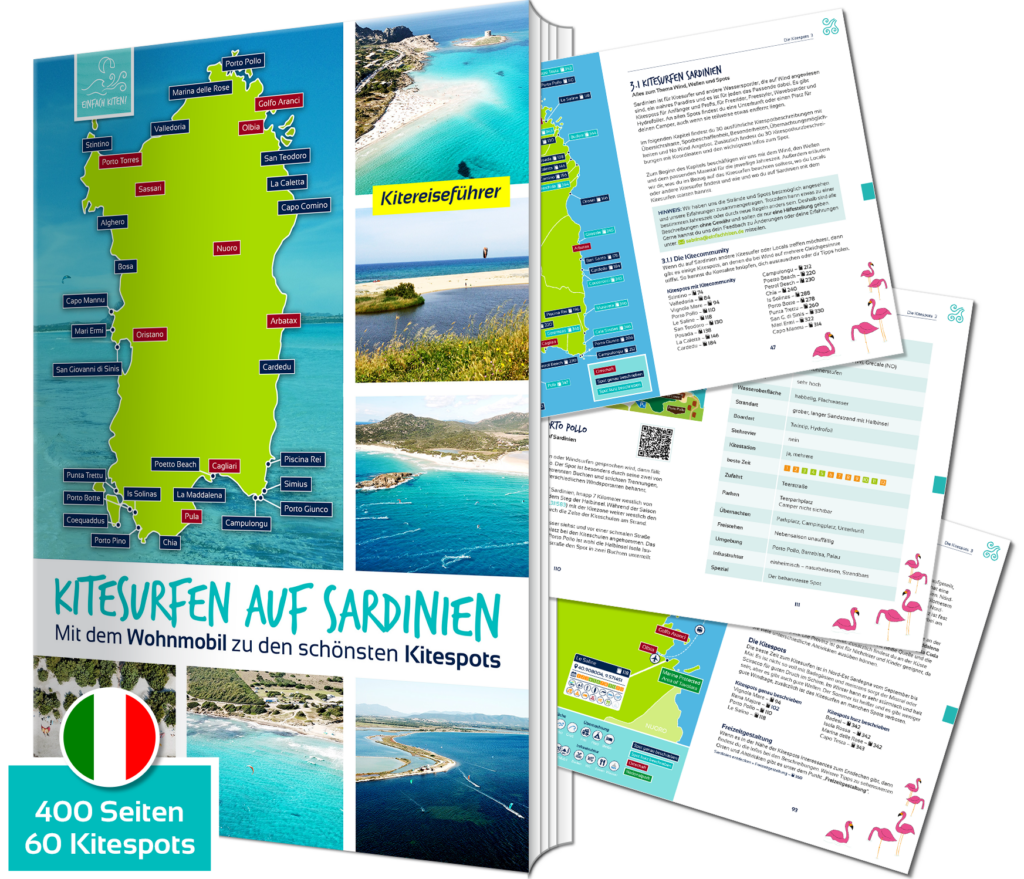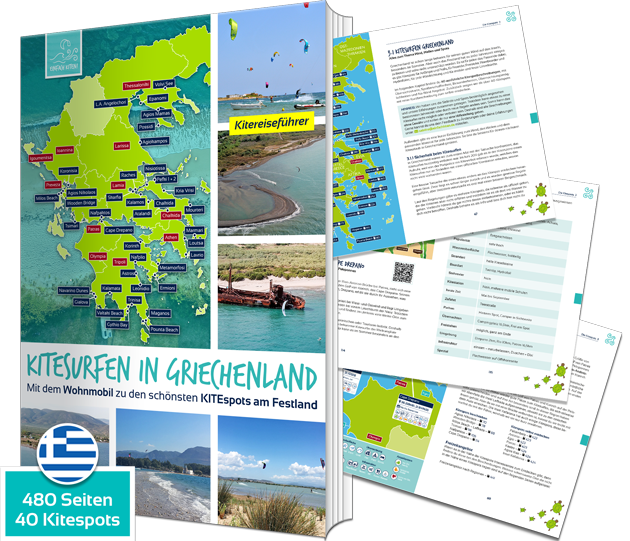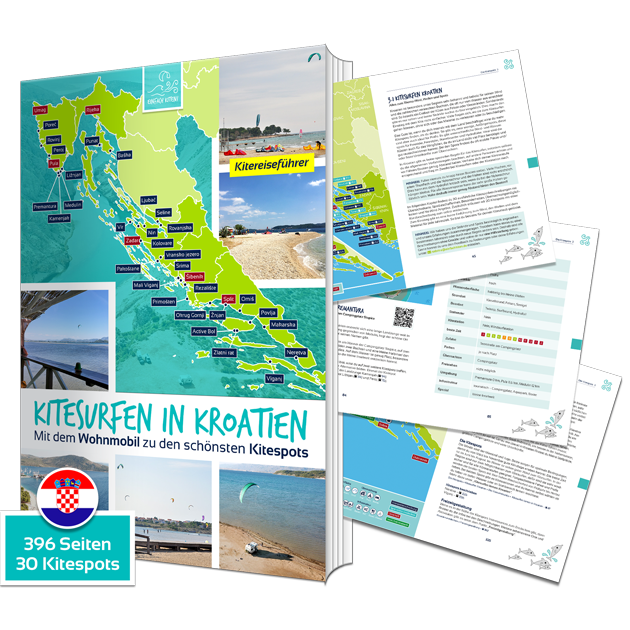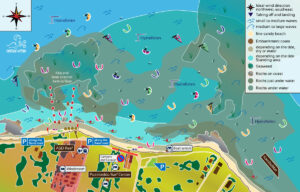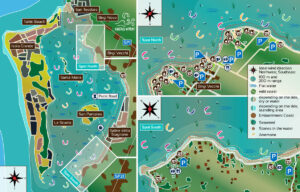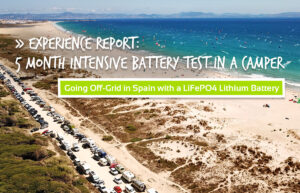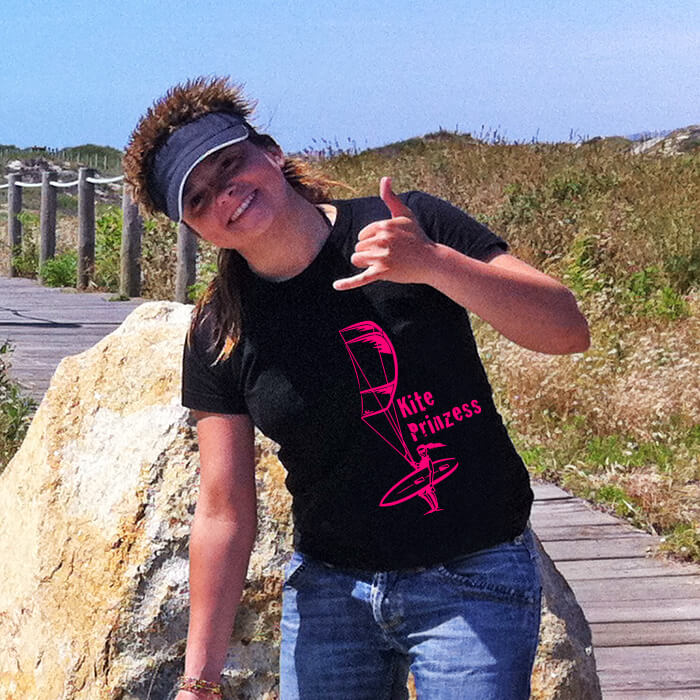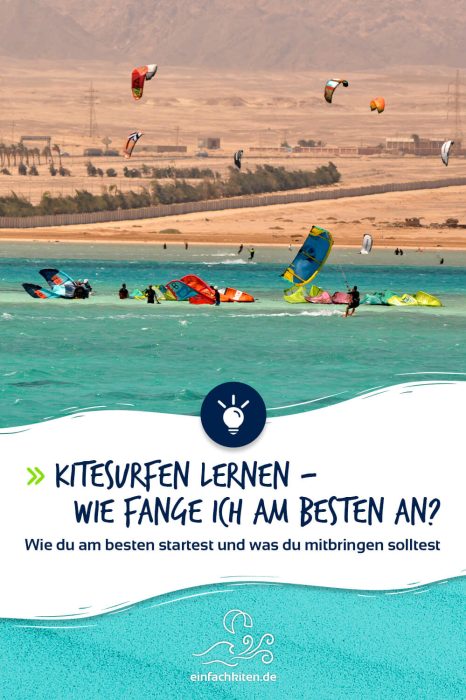Kitesurfing has to fight with many prejudices and not too seldom some are already taken away from the joy of kiting at the start. That’s why I’ve summarized in the following lines what basic requirements are advantageous and what you should pay attention to, so that the fun begins for you already at the start of your kite career.
The biggest problem why many keep postponing to start kitesurfing or quit too early is that they don’t take enough time and don’t remember that nature can’t be planned.
Some also got wrong tips or the kitespot, the kite school, or especially the kite instructor, were just not the right choice for them. Therefore, choosing the right kite school is very important and not every constellation suits everyone. Take the most time when choosing your kite school.
TIP Because this topic “Finding the right kite school”, is very complex, I will summarize everything important in a separate post.
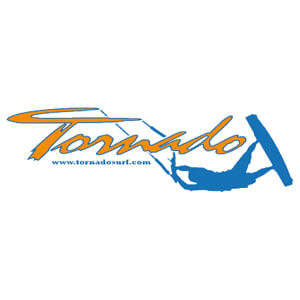 |
Tornado Surf Center |
|
|
Soma Bay, Safaga, Ägypten
übernommen Juli 2009
1-3 Kitelehrer
IKO Kitelehrer, IKO Kiteschule, VDWS Kitelehrer, VDWS Kiteschule
|
||
Do not wait any longer and learn kitesurfing
But you also like to get in your own way. Always postpone the registration with the kite school. Most of the time you let prejudices make you insecure, or you have too little confidence in your own skills and so you continue to stand on the beach and watch the others kitesurfing.
Just the desire to learn this wonderful sport is a good sign that you will be able to do it. Stop standing on the beach and watching others kitesurf, get on the board yourself. And believe me, the longer you put it off, the more annoyed you get that you didn’t get on the board much sooner. What are you waiting for, believe me it’s worth it.
Therefore, let’s get rid of some prejudices together. And after that, I’ll show you what to look for and what to avoid.
TIP If you have any questions, please feel free to send us an email.
From now on our KITE travel guides: Kitesurfing in Croatia, Kitesurfing in Greece,Mainland and Kitesurfing in Sardinia, are available in our store.
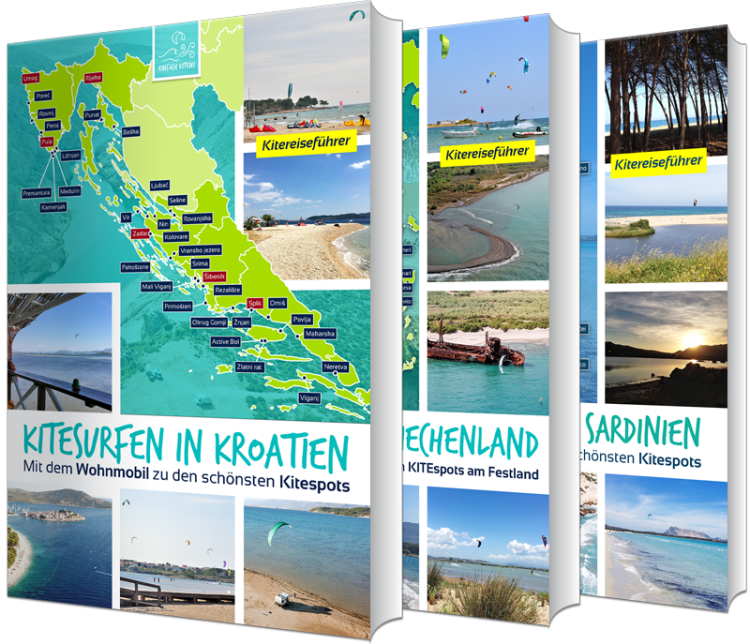
You will be confronted with these prejudices
I often hear statements like: “Kitesurfing is too dangerous”, “Kitesurfing is full hard to learn”,” My arms are not strong enough”, ” Kitesurfing is very expensive”, “I am too old to kitesurf” or “Kitesurfing is too time consuming“.
And? Have you heard one or the other statement or even used it yourself? If so, let’s illuminate and question them together. If not, then skip this part and find the right kite school for you.
1. kitesurfing is too dangerous
A typical prejudice often heard about kitesurfing is that it is very dangerous. And I can’t say now that this statement is not true. But it is not right either.
Don’t get me wrong, kitesurfing is an extreme sport, but if you approach it with the right knowledge and necessary respect (not fear), you will learn a wonderful sport that will enrich your life.
In the past, the sport was very notorious because the material had almost no safety devices and there were also fatal accidents. Today, however, much has changed and if you control your material well, then it is no more dangerous than windsurfing or skiing. That’s why it’s so important to attend a course in which you get to know the material and the necessary knowledge to behave properly in dangerous situations.
Kitesurfing is not more dangerous than other sports like skiing
You would like to learn more about the topic? Then visit my more detailed post: Is kitesurfing dangerous.
2. kitesurfing is full hard to learn
Here I can basically say no. Kitesurfing is easier to learn compared to other sports like skiing or surfing. For some people it can take longer, but basically everyone who wants to learn can get on the board.
In your kite course you will be introduced to the subject step by step, you can ask questions at any time and you will get the necessary knowledge how to handle the material best. So just enjoy the time and look forward to your future kiter life.
Kitesurfing is relatively easy to learn with the right knowledge
3. my arms are not strong enough
This is probably one of the biggest misconceptions about kitesurfing, that many think the sport is full on arms and only muscular people can kite. But that’s not true. In kitesurfing, the power of the kite, goes directly into the harness. This you have laced around the waist and thus you hold it with your body. You use your arms only to steer the kite, which requires little effort.
Therefore, the kite size is also selected according to your weight and wind strength. For this reason, you will see several different kite sizes on a kite beach because each rider is individual.
With windsurfing you need much more strength, especially when carrying it around, because the material is much heavier than with kitesurfing.
Kitesurfing is not a power sport
4. kitesurfing is very expensive
Yes, kitesurfing can be expensive if you always want the latest equipment. But you can also make it cheaper. In the beginning, the expenses for a first equipment will be a bit higher, because you should buy a neoprene and a harness in addition to the kite and board. So you come with a used initial equipment (1Kite, 1Board, new neoprene, harness) to about 1000€.
Then it depends on where you do your kite course (approx. 300 – 500€ – depending on the hours) and whether accommodation and meals are also included. Then you can start with 1500 – 2500 €.
TIP I will summarize the topic “kitematerial” in a separate post, because it is very complex. I covered how to find good used material in another post. If you still have questions or need help with a purchase decision, feel free to email us.
Kitesurfing does not have to be expensive
5. i am too old to kitesurf
This statement is definitely wrong. We often meet people over 50 who find the sport fascinating, but think they are too old. But as long as you feel fit and can swim, nothing stands in the way of kitesurfing later and you can learn to kitesurf at the age of 40, 50, 60 or even 70.
The oldest beginner kiteboarder we met was over 70 and he showed some young kiters how it’s done. Especially for windsurfers it is an option, if the material just gets too heavy for you, then many switch to kiting. Of course, you’ll have an easier time switching from windsurfing, but as mentioned above, learning to kitesurf isn’t hard. And if you feel so fit, then off you go on the board.
Learning to kitesurf at 50 is not a problem
6. kitesurfing is too time consuming
Actually, it is only very time-consuming at the beginning, after that it depends on you how much time you want to invest in this sport. Depending on the spot distance, you can also just get on the water quickly before work and have a short term session, because the kitesurfing itself lasts as long as you want.
You can set up your equipment in about 5 – 15 minutes, depending on the type of material, water temperature and speed, and then you can plunge into the water. Here you drive as long as you want and then you reassemble everything in the same time.
Kitesurfing is only as time consuming as you want it to be
So if you’re standing on the beach and get all excited at the sight of colorful kites, then you should definitely learn kitesurfing. Don’t be put off by the prejudices, make up your own mind! And if you are still unsure and have questions, then just write to us.

What are the basic requirements for kitesurfing?
Now that we’ve got all the prejudices and fears out of the way, let’s talk about what you should bring with you and what you should look out for. Basically, anyone can learn how to kitesurf.
The best prerequisite is if YOU want to learn kiting and not do it for someone else. It can go well, but most of the time it is not beneficial. Of course, it’s nice when someone nevertheless discovers this great sport this way and ends up enjoying it, but it’s more the exception.
Physical requirements for kiting
A certain basic fitness is an advantage and you should weigh at least 30 kg. To be able to serve the material sufficiently is also a Body height from min. 1.40 m ideal. Of course, you can also adjust the material accordingly, but this should be decided in particular. Upwards there is actually no limit, there is also for large sizes the right material.
Even physical limitations such as prostheses or a walking disability, does not have to stop you from learning to kitesurf. So you should have a good physical condition, or know how to best handle it. However, it is best to discuss this with the kite school of your choice and your doctor, how they assess the situation in each case.
As already mentioned, it doesn’ t matter how old you are, here it only depends on how you feel, keyword: good basic fitness. And so, as with any sport, the fitter you are, the lower the risk of injury.
From now on our KITE travel guides: Kitesurfing in Croatia, Kitesurfing in Greece,Mainland and Kitesurfing in Sardinia, are available in our store.

Other features in kitesurfing
One important quality is that you can swim. It is also an advantage that you like the water, although there have been some who did not let this stop them. Here it might be a good way to learn kitesurfing first in the snow and then approach the water.
Even timid types can learn kitesurfing, they may even have a small advantage because they practice everything more thoughtfully. It is only important that you get involved and turn fear into respect. Here, in any case, the kite instructor is asked to take you by the hand and to respond to you. Feel free to mention this in your search for a suitable kite school and talk to the kite instructor.
In any case, don’t give up if it takes you a little longer.
You will definitely reduce your risk of injury if you have a good sense of responsibility and do not overestimate yourself, or recklessly put yourself in danger. Also, if you have good motor skills and can quickly implement movement sequences, this can help you further in kiting.
It can be an advantage if you are already doing a board sport, or already have experience with the wind. But in any case it is not necessary, you can learn kitesurfing without any previous knowledge. Sometimes knowledge may get in your way.
What I should also mention is that you either be patient, or best of all become so, because in kitesurfing this is often put to the test. Of course, there are kitespots that have a high wind probability, but the wind is and remains unpredictable. So be prepared to spend some time waiting for the wind in the future. You can best adapt to new situations spontaneously and always have an alternative ready.
The requirements for kiting at a glance
- You want to learn kitesurfing
- You have a good basic fitness
- You weigh min. 30 kg and are min. 1.40 m tall
- You can swim well
- Don’t let your age stop you
- Even as a fearful person you can learn kitesurfing
- Good sense of responsibility
- No previous knowledge is necessary
- Be or become patient and spontaneous
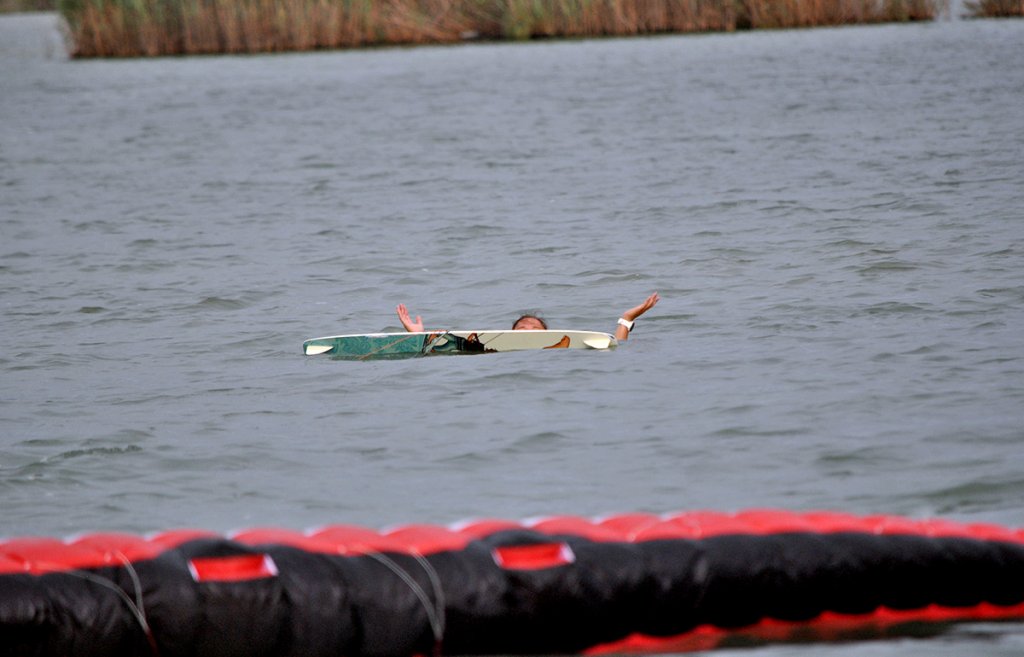
How long does it take to learn kitesurfing?
Of course, this depends on several factors, such as wind, time and skill. Let’s say you attend a 12 hour beginner course, which lasts about 4 days and you have good wind every day. Depending on your skill level, you can go back and forth after that. If you then continue to practice for say 1 week, with good wind, then the altitude should work out (you arrive where you started).
So theoretically you can learn kitesurfing in 12 days, if it has perfect conditions. However, this usually doesn’t work out the way you imagine. The wind, in particular, often throws a spanner in the works. But if you take intensive time at the beginning and use every free minute to be on the water, then you can, including the break days, learn kitesurfing in 3 – 4 weeks.
Learning to kitesurf lasts approx. 12 days – 3 – 5 days course + remaining days independent practice

Why should I take a kitesurfing course?
Besides the above mentioned prejudices, there is another one that is absolutely not true: “I can teach myself to kitesurf”. Even if you are a sporty type and are easy with new sports, you should definitely not teach yourself kitesurfing.
In kitesurfing there is on the one hand the material, which you should know well and on the other hand the wind, which should not be underestimated.
Selfish behavior in kiting harms the whole kite community
When learning by yourself, something can quickly go wrong and you react incorrectly, then the situation can not end well. And many a person then quits without really having started. So don’t have false pride and go to a kite school and get the basics explained to you! It is and remains an extreme sport, you play with two elements at the same time, wind and water. Therefore, you should know your kite material well. Especially how you behave in dangerous situations.
I write this so harshly on purpose so that people will finally stop being so flippant and learn this wonderful sport properly from the ground up. It also gets you on the kiteboard much faster and you can enjoy kitesurfing much more.
On the other hand, such accidents, which are caused by self-infliction and wrong behavior, cast a bad image on the entire kitesport, which again fuels the prejudice: “Kitesurfing is very dangerous” and can lead or has already led to kite bans.
Therefore no learning kitesurfing without a course!
First experiences with the trainer kite
But what you can do to prepare yourself ideally for your kite course is a trainer kite. This is the ideal way to practice kite control and get a good feel for the kite and the wind.
The important thing here is that you use a trainer kite and not a power kite. The difference is that a trainer kite has only two lines (a third is the safety) and you tie the bar (handlebar) to your wrist with a leash. The kite itself is 2 – 3 square meters.
A power kite has at least four lines and the two extra lines (the centerlines) are passed through the bar and attached to your harness using the chicken loop (the loop at the end of the bar). You will get to know this in more detail during your training.
TIP When buying a trainer kite, you should make sure that the kite has a handlebar (not individual handles) and it does not have power lines. Additional lines for securing are quite useful and so the kite can also be launched well backwards. A good trainer kite is for example the Skymonkey*.
My friend/acquaintance is a kite instructor?
A not uncommon scenario is when your partner or friend is a kite instructor. Then the decision seems quite easy in the first place. Of course you learn kitesurfing with him or her.
But among friends or especially couples, this can be very difficult, because you deal with each other quite differently than strangers. The inhibition threshold to shout at each other or to argue is much lower. Relationships and even friendships have already been broken during such actions. Thus, think carefully whether you want to take this risk.
On the other hand, it is a good test for your relationship because if you are still together after that, then you can get married. 😛
TIP If you decide to take this step, make up rules or maybe even a safe word beforehand. Hannes and I also set up rules to prevent unnecessary arguments. This usually works 😛 very well.
I learn kiting with good kiters
Also an often chosen situation is when you already have one or more good kiters in your circle of friends and then just go along and learn kitesurfing from them.
This sounds very good at first, because you save the kite course. But be careful, if your friend/acquaintance is not a kite instructor, then he has no routine in training and forgets, quite unintentionally, important tips, because they are already in the flesh and blood.
In addition, you need intensive support in the beginning, no matter what the wind is like and how much the other person would like to kitesurf. Then he may not be with you with his head, which would be quite normal when the wind calls.
That’s why you should take a beginner’s course and afterwards you can always get tips and tricks for your further way.
You can also find good tips in various kitesurfing groups on Facebook.
Our groups are:
- Kitesurfing in Sardinia
- Kitesurfing in Greece
- Kitesurfing in Egypt
- Kitesurfing in Montenegro
- Kitesurfing in Albania
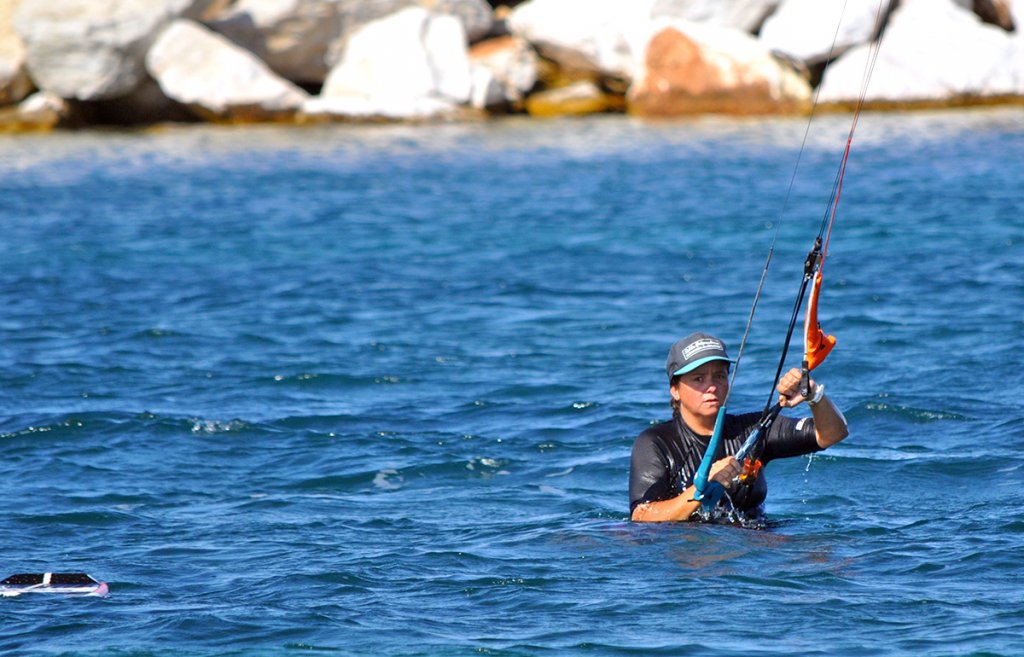
What can I expect from kitesurfing?
You have been watching these beautiful colorful kites on the water for a long time and you know you want to learn how to do this yourself. As already said the best decision 🙂
You should be aware of the following points beforehand:
- To start you need about 500€ for the course and about 1000€ for the initial equipment.
- Your first important decision is the choice of the kite school
- You should invest a lot of time in the beginning and not have too big breaks
- Keep at it, even if it doesn’t work out right away.
- You ride and are a kitesurfer from now on, your thoughts are only about kiting
- You buy your first kitematerial
- You spend your free time and vacations kitesurfing as often as possible
- You always want to learn new things and be able to do the latest tricks
- Your money goes for kitesurfing
- Conflicts may arise with non-kiters close to you, regarding vacations or free time
- You’ll do just about anything to get on the water
Now you know what to expect, so what are you waiting for 😀
What is the best way to learn how to kitesurf?
The most important thing is that you invest more time in the beginning. This intensive phase should last at least until you can ride at altitude. By then, your kitesurfing will have solidified to the point where you can take a longer break without having to start all over again.
The best introduction to kiting
It’s best to book a complete package with a beginner’s course and equipment rental afterwards. So you can deepen your learned and always have the right material for the conditions at the kitespot. In addition, the kite school keeps an eye on you, you can ask questions or get help or tips and in case of emergency, depending on the spot, a rescue service is also available.
After that, you take at least one, maximum two weeks and go back on the water for another 2 weeks. If you know for sure that you want to continue, then you can definitely already get your own harness and, depending on the water temperature, a neoprene. It is always more pleasant to ride in your own.
After the 2 weeks you should be able to hold altitude, if the wind has played along, and have consolidated what you have learned so well that you can take a longer break.
Now your free time, your skills, your wallet and your spontaneity decide how often you get on the water and how far away the next kitespot is.
If you still feel insecure after a longer break, there is no shame in taking another lesson at the kite school. You will see, your body has remembered this great sport.
The agony of choice
If you have decided to learn kitesurfing, you should think about where and how you want to learn kitesurfing before choosing a kitesurfing school.
If you already have a kite school that you really want to go to, then this consideration is eliminated and it’s just a matter of how you get there and if you need a place to stay.
The how, where and the kite instructor decides a lot about how fast you learn kitesurfing. Why? Because you can make it very easy or more difficult for yourself here. Not every kite school is located at the perfect beginner spot. And it’s also very much up to you what you want. On vacation or near you, in deep water or standing water or in summer or winter.
You should think about these three points in advance:
- Learn kitesurfing at home/on vacation
- Learn kitesurfing summer/winter
- Learn kitesurfing in standing area/with boat training in deep water
From now on our KITE travel guides: Kitesurfing in Croatia, Kitesurfing in Greece,Mainland and Kitesurfing in Sardinia, are available in our store.

Learn Kitesurfing At Home
If you are lucky enough to have a good kitespot with a kitesurfing school in your area, then it is a good idea to learn kitesurfing there. This way you can organize your free time ideally. I’ll explain below how to find the ideal spot.
If you don’t have two weeks at a time, you can split your course and take 2 days each weekend and continue practicing afterwards. Especially at the beginning, never take longer breaks than max. Be 5 days in between. Otherwise it is always difficult to get back in. The longer the pause, the more you slide back to the beginning. Again, maintain the intense phase until you can safely ride altitude.
Learn kitesurfing on vacation
This is actually ideal and combines well with the “best start” described above. You can just fully concentrate on kitesurfing and have a good learning curve.
But beware, there may be no wind, so still have a plan B. In any case, check the wind statistics of your destination and choose the best possible travel time. Ask the local kite school when the best time is and how flexible they are. Of course, things can still turn out differently, because the wind often does what it wants.
TIP
It is best to choose a destination that you can reach by car/train/bus, or where you can book very spontaneously to check the wind beforehand.
No matter what you decide, in the beginning you should invest a lot of time, at least four weeks. Either you decide on larger blocks at a time or many smaller ones on weekends and the breaks in between should never be too large in proportion. If you can hold altitude for a while, you’ll arrive back where you started, and then you’ll be able to handle even longer breaks. It’s like riding a bike.
Learn kitesurfing in winter
If you are shy of water, or just love the winter, you can learn kitesurfing in the winter at Snowkiting. You will get to know the material in the same way as in summer and have the same theory.
The biggest difference is that snowkiting eliminates the water start, since you don’t have to get out of the water. And if you stop, you won’t sink. Therefore you need less pressure to move forward and so you need a smaller chute like on the water.
Otherwise, you use either skis or a snowboard and let yourself be pulled over the snow. Just like the other winter sports, you should wear a helmet because the snow and ground is harder than the water.
Especially if you already know how to ski or snowboard, this is an easy introduction for you to kitesurfing. You will learn a good kite control and so you can fully concentrate on the waterstart and the bodydrag in the water. Both of course not without respective kite course.
Kite lessons in the standing area or from the boat
In a kitesurfing course there are two basic ways to teach kitesurfing. Once there is a large standing area where you make your first kite attempts, or you are immediately taken into deep water and learn kitesurfing there.
There are different opinions on which way is best. Hannes, for example, learned it at the Neusiedler See in the standing area and then went to other kitespots. I learned kitesurfing from the boat at Lake Idro and then had my first solo flights in Sardinia in Porto Pollo. And we both kite now since 2010. As you can see, you can reach your goal in both ways.
Therefore, here are the advantages and disadvantages of the two types of training:
Stehrevier
+ you can stand
+ and so you can fully concentrate on the kite
+ the kite instructor can intervene in case of emergency
+ you learn how to launch your kite on land
– increased risk of injury due to the shallow water
– the bodydrag is often neglected
– more students
– you have to walk back
If you learn in the standing area, persevere with the bodydrag despite this
Once you can drive you should go into deep water and get a feel for it. Again, practice the body drag, it is very important. This way you avoid getting scared of the deep water, which would be absolutely unfounded.
Boat training
+ you become familiar with deep water
+ you quickly learn the bodydrag
+ you know what it means when the kite is in the water
+ fewer students and a lot of space
+ you are driven back
– the kite instructor cannot directly intervene
– you can not stand
– Kite is not always launched on land
If you do not yet have a routine in taking off or landing, then you should go over this again with someone. This should really sit.
It’s best to have a kitespot that offers both, deep and shallow water. This way you can practice kite control and water launching in shallower water. Then, when you can drive, you go out into the deep to get your first experience.

What characterizes a good beginner spot?
Choosing the kite spot where you want to learn to kite can go a long way in determining how quickly or well you learn to kitesurf. Most spots that are good for schooling also have a kite school on site.
On the other hand, it is not necessarily the case that every kite school is located at a good beginner spot, so you should take a closer look at it in advance. Because even the wrong kite spot can affect your learning speed.
The ideal kitespot
To get one thing straight, the perfect spot to learn kitesurfing does not exist in reality, but there are some that are good to get to or are made a good spot by the local schools.
The optimal training area in descending importance:
- no obstacles in the water or downwind (windward side)
- no rocks in or near the water
- no big waves or currents
- Wind hits the land at a +/- 30degree angle
- plenty of space on the water and on land
- No trees on the beach or other major obstacles
- Kiteschool is directly on site
- constant wind from morning to evening (12 to 25 knots)
- fine sand in the entire kite area
- approx. 50 – 100 meters large standing area
- Water depth above waist level – not less than 1 m
- outside deep water to practice further
- pleasant water temperature
- several wind directions work
- the wind is not offshore or directly onshore
The more of these characteristics a spot meets, the better, with the first 6 being the most important. If the spot does not have a standing area, this is not bad, because you can then also be trained from the boat. Here you have to decide for yourself what you prefer, above I have already shown you the advantages and disadvantages.
When choosing a kitesurfing destination, you should also check the wind statistics and ask the local kite schools when the best time would be. You can target the travel time with the most matches. However, this is unfortunately not yet absolute certainty. As already mentioned the wind is unpredictable.
Therefore it is always best if you can book spontaneously.
One of the best beginner spots in Central Europe is simply Egypt. You are there in four hours (Hurghada, El Gouna), you can book spontaneously, you have many kite schools to choose from, a high wind probability, warm water, shallow and deep water, wind blowing along the beach, good rescue, nice kite stations, shallow to choppy water, vacation flair.
Otherwise it is still the North Sea and Baltic Sea, Holland, Sardinia, Fuerteventura, Brazil
Good lakes are also the Neusiedler See, Reschensee, Silverplaner, Brombachsee.
Snowkitespots
Feldberg, Westerheim, Bayrischzell/Inntal, Achensee, Reschensee, Obertauern, Norway
Hang in there it’s worth it
It doesn’t matter if you are just thinking about starting kitesurfing or if you are already in the middle of it. Maybe you took a course a long time ago, but then didn’t stick with it.
When kiting, you should not give up before the water start and have ridden at least your first meters. Only then you can really decide if you want to continue this sport or not.
Don’t get discouraged if it takes longer. Many factors come into play here as to why others may have been faster. In the end, this doesn’t matter how long it took you to get on the board. What matters is what fun you have doing it. You probably subconsciously gave yourself more time to savor this moment for a really long time. The moment when your kitesurfing life starts and nothing will be the same anymore.
And another warning
Once you have safely ridden your first meters in both directions, you will be addicted to the sport and in the future you will plan your vacations according to kite spots, spend your money on kite equipment and constantly check the wind. But it’s damn well worth it!
Many wait far too long to sign up for a class. DARE NOW 🙂

